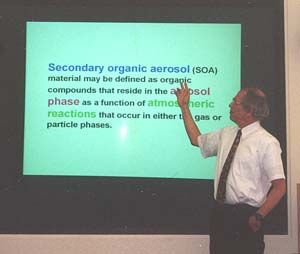
|
Statement of the Problem (Revised 1/13/03)
Total carbon is reliably measured by heating oxidation, conversion
to carbon dioxide or methane, and detection of the evolved gases.
The EC fraction has been determined by thermal evolution of particles
collected on a filter under different temperatures and atmospheres,
light reflectance and transmittance through particles collected
on a filter, sequential organic extraction of particles from a
filter, and the in-situ heating or particles in an air stream
with photoacoustic detection. Several methods report more refined
sub-fractions that can be combined to accommodate different definitions
of OC and EC. These carbon analysis methods do not consistently
provide comparable EC concentrations, as demonstrated in many
intermethod and interlaboratory comparisons. The degree of equivalence
depends on the nature of the sample (particle and filter) as well
as on the analysis method and protocol. Different protocols are
followed under the same method, but potentially important differences
that might affect the comparability are not adequately documented.
A more fundamental approach is needed to understand the reasons
why these discrepancies exist, how carbon sampling and analysis
methods should be documented, and how OC and EC concentrations
should be reported and validated. Abstract and Workshop Goals A. Clarification of Carbonaceous Aerosol Terminology B. Identify and Explore Limitations of Current Organic
Aerosol Sampling Technologies Goal 2: Address sampling difficulties such as
the condensability (i.e., positive artifacts) and volatility of
organic species (i.e., negative artifacts), and develop a strategy
for sampling specific types of organic aerosols depending on their
physical and chemical attributes. Goal 3: Recommend standardized analysis method to distinguish organic carbon aerosol species from elemental carbon. Goal 4: Develop and recommend standardized analysis methods to measure specific classes of organic aerosols. These standard methods would allow inter-laboratory comparisons of data, which will be necessary for the development of organic aerosol formation simulation models. Goal 5: Develop and recommend standardized
analysis methods to distinguish secondary organic carbon aerosol
species from primary organic carbon aerosol species. |
| APACE | SOA | OCEC Home | Contact Us |
 Organic carbon (OC) and elemental carbon (EC) constitute large
fractions of the PM10 and PM2.5 mass in ambient air. EC, sometimes
termed “black carbon” or “soot,” is usually
produced by incomplete combustion of organic gases and particles.
It is not pure or highly structured carbon such as diamond and
graphite and rarely occurs as a pure particle unmixed with other
atmospheric constituents. OC, EC, and other fractions of the carbonaceous
aerosol are relevant to adverse health effects, urban and regional
haze, the Earth’s radiation balance, and the attribution
of ambient particle concentrations to their sources.
Organic carbon (OC) and elemental carbon (EC) constitute large
fractions of the PM10 and PM2.5 mass in ambient air. EC, sometimes
termed “black carbon” or “soot,” is usually
produced by incomplete combustion of organic gases and particles.
It is not pure or highly structured carbon such as diamond and
graphite and rarely occurs as a pure particle unmixed with other
atmospheric constituents. OC, EC, and other fractions of the carbonaceous
aerosol are relevant to adverse health effects, urban and regional
haze, the Earth’s radiation balance, and the attribution
of ambient particle concentrations to their sources.